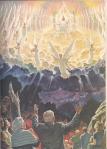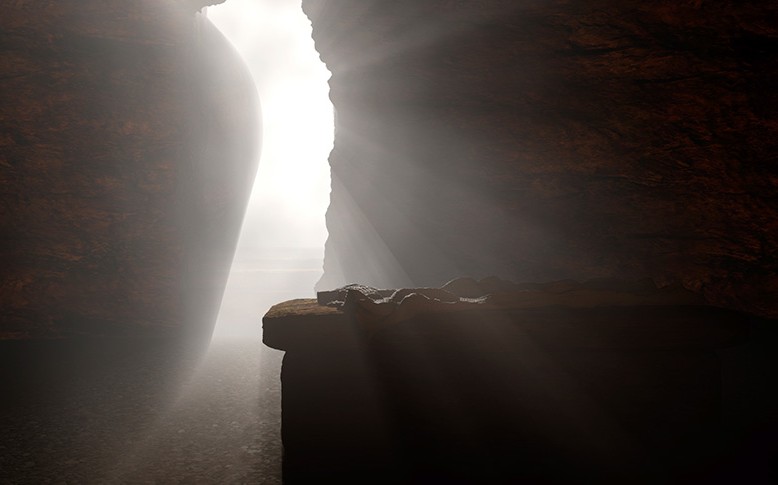 The final essential doctrine on our list is the doctrine of the return of Christ. The return of Christ may have various interpretations as to when the return will occur, but there is no debate that the return of Christ will occur. Let the reader know that this writer does not support any date-setting by any person be they orthodox in their beliefs or be they of a cult. As one will see, the time of Christ’s return is unknowable by the human mind. I have said more than one time that even if someone were to accurately date the moment of Christ’s return that God would probably delay the return of Christ just to prove that person wrong. This article will seek to present the details of the doctrine concerning the return of Christ, give reasons why the doctrine should be believed, and why the doctrine is essential in nature.
The final essential doctrine on our list is the doctrine of the return of Christ. The return of Christ may have various interpretations as to when the return will occur, but there is no debate that the return of Christ will occur. Let the reader know that this writer does not support any date-setting by any person be they orthodox in their beliefs or be they of a cult. As one will see, the time of Christ’s return is unknowable by the human mind. I have said more than one time that even if someone were to accurately date the moment of Christ’s return that God would probably delay the return of Christ just to prove that person wrong. This article will seek to present the details of the doctrine concerning the return of Christ, give reasons why the doctrine should be believed, and why the doctrine is essential in nature.
What is the doctrine?
The doctrine of the return of Christ, or the parousia, speaks to the physical return of Jesus upon the earth. Theologians differ on the events surrounding the return of Christ. Certain variations exist around the thousand year reign of Christ as mentioned in Revelation 20 where Satan will be bound. Amillennialists believe that the thousand year reign is allegorical and refers to the time between Christ’s ascension and the final return to earth. Millard Erickson states that amillennialists believe that “there will be no millennium, no earthly reign of Christ…it is a simpler view than any of the others that we have been considering” (Erickson 1998, 1218). Millennialists believe that the millennial reign is a literal reign of Christ on earth. Millennialists differ as to when Christ will return around this reign. Post-millennialists believe that Christ will return at the close of the millennium. Like amillennialists, post-millennials believe that the millennium is the reign of Christ found in the church between the ascension of Christ and the second advent of Christ. Post-millennials are optimistic. Post-millennials believe that the world will finally embrace the gospel message and become better and better until Christ returns. As far as the millennial reign, somewhat like amillennials, post-millennials believe that the church age is the millennial reign of Christ.
Pre-millennials are not so optimistic. Pre-millennials believe that Christ will return before establishing the earthly millennial reign on earth. Pre-millennials believe that the world will become more and more perverse before the return of Christ. Traditionally, pre-millennials are divided into three camps based on their interpretation of Christ’s return around a period of time called the Great Tribulation. The Great Tribulation is a period where the anti-Christ (Satan’s representative on earth) will arise and lead a massive rebellion against the church. The division among Christians stems from when the coming of Christ will occur around this time of tribulation. Pre-tribulationalists believe that Christ will return to “rapture” (from Latin “raptura”), or rescue the church, from the time of tribulation (a time when the anti-Christ will reign and the judgment of God commences) which will be followed by the return of Christ ushering in the millennial reign. For pre-tribulationalists, the rapture will resurrect the saints of God while the Second Coming of Christ will usher in the resurrection of the unbelievers. So in essence, there is a second (rapture) and third (advent) appearances of Christ. Post-tribulationalists believe that the rapture and return of Christ are the same event which will occur following the time of tribulation and ushering in the millennial reign of Christ. Post-tribulationalism is much darker than pre-tribulationalism. For post-tribulationalists, the church will endure extreme persecutions towards the end of time. Mid-tribulationalists believe that Christ’s rapture will occur during the middle of the tribulation.
While theologians differ as to when the return of Christ will occur, all Christians will agree that the return of Christ will occur. The New Testament speaks in great depth as to the return of Jesus Christ. Contrary to what many date-setters would have you believe, the gospels state that the time of return of Christ is unknown (Matthew 24:36; Mark 13:32). It is also said that Christ will restore all things (Acts 3:21; Romans 8:21). Jesus will appear visibly (1 Peter 1:7). Jesus’ return is foretold by the prophets (Daniel 7:13; Jude 1:14), by Jesus Himself (Matthew 25:31; John 14:3), the apostles (Acts 3:20; 1 Timothy 6:14), and angels (Acts 1:10, 11). Jesus tells of signs that will precede His return (Matthew 24:3-51).
Of Jesus’ return, it is said that Jesus will come in the clouds (Matthew 24:30; Revelation 1:7), in the glory of the Father (Matthew 16:27), with power and great glory (Matthew 25:31), with the shout of the archangel (1 Thessalonians 4:16), joined with angels (Matthew 16:27), and with the saints (1 Thessalonians 3:13). Jesus’ return will take place at a time when no one expects (Matthew 24:44) and would take place suddenly (Mark 13:36) like a thief in the night (2 Peter 3:10) and as the lightning (Matthew 24:27) in which everyone will see (Revelation 1:7) Christ in His glory.
Why should the doctrine be believed?
Four particular reasons exist, among others about why a person should believe in the return of Jesus Christ to earth.
The Ascension of Christ
One of the reasons that a person should believe in the return of Christ is due to the ascension of Christ. Luke writes, “And after He had said these things, He was lifted up while they were looking on, and a cloud received Him out of their sight” (Acts 1:9-10). The ascension of Christ indicates that Christ passed into the heavenly dimension. A recent paper that I wrote will be posted on this website soon. The paper presents a case for the ascension of Christ as a real event. Look for it on the website soon. What will be said in the brief portion we have in this article is that if the ascension is true in that Christ passed into the heavenly realm, then it can be expected that Christ will return in like manner. The disciples were left with the promise that this “Jesus, who has been taken from you into heaven, will come in just the same way as you have watched Him go into heaven” (Acts 1:11b).
The Promises of Christ
If a person is proven to be trustworthy, then it is easier to trust that person’s promises. Jesus made several promises which were fulfilled. Jesus told the disciples that He would be crucified and resurrected. For instance, Jesus said, “Destroy this temple, and in three days I will raise it up” (John 2:19). The apostle later explained that Jesus was “speaking of the temple of His body. So when He was raised from the dead, His disciples remembered that He said this; and they believed the Scripture and the word which Jesus had spoken” (John 2:21-22). Jesus fulfilled the amazing promise of His resurrection from the dead. If Jesus fulfilled what seemed to be an unlikely promise, than Jesus can be trusted when He claimed that He would “go and prepare a place for you. If I go and prepare a place for you, I will come again and receive you to Myself, that where I am, there you may be also” (John 14:2b-3). Since Jesus went to heaven with a resurrected body, the promise of Jesus includes the resurrection of the believer (1 Corinthians 15). Therefore, Jesus promised to return and bring a new form of existence. This will be fulfilled in the ascension which adds one more reason to accept the ascension as a real event.
The Proof of an Afterlife
Is there evidence for an afterlife? Due to recent indications, it seems so. The resurrection of Christ is one such evidence and the evidence of those He brought back from death. But, is there any modern evidence that supports such a claim? Near-death experiences seem to provide such evidence. Near-death experiences (NDEs) are experiences that a person has outside the body. Several accounts exist where individuals have experienced God and loved ones in heaven and came back to tell about the experience. But, as Gary Habermas suggests, “the experiences of heaven and hell cannot be proven scientifically. What we are looking for is evidence to suggest that people witness things in this world while out of the body. That is verifiable” (Habermas, 2013). Of such cases, the evidence is strong. Habermas and Licona state that, concerning NDEs, “the amount of verification is sometimes staggering. People blind from birth have correctly recalled visual details of things around them and outside their presence. Many of these near-death details were of events occurring when the individual had no heartbeat or brain wave activity, as indicated by ‘flat’ EKG and EEG readings, sometimes over lengthy periods of time” (Habermas and Licona 2004, 146). Some have dismissed NDEs due to philosophical and theological problems such as atheists experiencing heaven. What must be remembered in such cases is that the atheist experienced something while it was known…at least to God…that the atheist would return to his/her body. Would the same result have occurred if the person were to remain apart from the body? It would not according to the Bible. The fact is; God may use different means to reach people. For instance, Paul was not a believer when he experienced the Risen Jesus on the Damascus Road (Acts 9:1-19). Jesus, in fact, told Paul, “I am Jesus, whom you are persecuting…Now get up and go into the city and you will be told what you must do” (Acts 9:6, NIV). Most individuals who have these NDE experiences are changed for the good after having experienced them. Some would ask, “Yeah Pastor Brian, but what of all the differences between the experiences? Doesn’t that negate the experience’s validity?” Those are great questions. However, there may be reasons for the differences. While all the claims of Eben Alexander are not agreed upon by this writer, nonetheless Alexander, a man who had a phenomenal NDE in Virgina, gives a possible explanation as to why there are differences in the experiences. Alexander said that “because I experienced the nonlinear nature of time in the spiritual world so intensely, I can now understand why so much writing on the spiritual dimension can seem distorted or simply nonsensical from our earthly perspective” (Alexander 2012, 143). It would seem that it would be difficult for a person to relay the information found in the heavenly dimension to the earthly sphere. Perhaps this is why one finds so many symbols in apocalyptic literature such as the book of Revelation. Nonetheless, the evidence for an afterlife is so strong that the naturalist may find it difficult to explain away all the cases of NDEs. Furthermore, while NDEs do not prove the return of Christ as a reality, it does demerit the naturalist’s claim that the return of Christ is impossible.
Why is the doctrine essential?
The doctrine is essential due to the promise of glorification. Glorification refers to the “time, when, at the parousia, those who died in Christ and the living believers will be given resurrection bodies” (Grider 2001, 484). Also, the doctrine is essential due to the establishment of a new physical order of creation. In other words, it is at the return of Christ that the resurrection of humanity will take place (for pre-tribulational, pre-millennial theologians; the resurrection of the righteous will take place at the rapture and the resurrection of the wicked will take place at the second coming of Christ). Also, it is at this time that God will make all of creation new (Isaiah 65:17). Erickson, perhaps, puts it best as he writes that the “doctrine of the second coming is sometimes made a topic of quarreling among Christians. It is instead, as Paul indicated, an encouragement to hope and comfort…” (Erickson 2001, 1083).
Conclusion
Since Jesus has lived up to all of His promises, the promise of Christ’s second return should be trusted as well. For Christ has made the impossible…possible and the unbelievable…believable. For the believer, the return of Christ completes the circle of essential doctrines. The return of Christ will prove the existence of God to all of humanity forevermore; will rectify the problem of sin forevermore; will complete the work of the incarnation, atonement, and justification of faith found in the work of Christ; will bring forth the final resurrection as Christ was raised; will demonstrate the triune nature of God as the Spirit brings people from the dead, are confronted by the Risen Son, while being ushered into the Father’s presence; the church will be perfected in the kingdom of God; and the kingdom of the Devil will be quarantined forevermore. This concludes our list of essential doctrines. These essential doctrines make up the crux of classical Christian orthodoxy. While there may be differences of opinion on precise matters, these general doctrines comprise the primary beliefs that make Christians Christian.
Bibliography
Alexander, Eben, M.D. Proof of Heaven: A Neurosurgeon’s Journey into the Afterlife. New York: Simon and Schuster, 2012.
All Scripture, unless otherwise noted, comes from The New American Standard Bible. Grand Rapids: Zondervan, 1995.
Erickson, Millard J. Christian Theology, 2nd Edition. Grand Rapids: Baker Academic, 1998.
Erickson, Millard J. “Second Coming of Christ.” Evangelical Dictionary of Theology, 2nd Edition. Edited by Walter A. Elwell. Grand Rapids: Baker Academic, 2001.
Grider, J. K. “Glorification.” Evangelical Dictionary of Theology, 2nd Edition. Edited by Walter A. Elwell. Grand Rapids: Baker Academic, 2001.
Habermas, Gary. “Ten Reasons for the Fall of Atheism.” Lecture. National Conference of Christian Apologetics. Southern Evangelical Seminary. Charlotte: First Baptist Church of Indian Trail. (October 2013).
Habermas, Gary R. and Michael R. Licona. The Case for the Resurrection of Jesus. Grand Rapids: Kregel, 2004.
Many references were obtained from Torrey, R. A. The New Topical Text Book: A Scriptural Text Book for the Use of Ministers, Teachers, and All Christian Workers. Oak Harbor, WA: Logos Bible Software, 2001.
Scripture quotations marked as (NIV) come from The New International Version. Grand Rapids: Zondervan, 2011.





